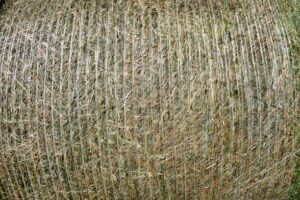Baler twine is a strong, rot-resistant material that helps to hold straw and hay bales together. A straw baler twine will also resist mildew and insects. It can be made of either natural fibre or polypropylene. It is available in a wide range of colours and is supplied on spools or rolls to suit specific needs.
Durability
Baling twine is an essential part of baling hay and straw, as it helps keep the bales tight and secure during storage. It is available in various weights, diameters and knot strengths, so farmers can choose the type that best suits their needs. In addition to ensuring quality storage, it is also important that twine be used appropriately. Choosing the right twine is vital for preventing baling problems, including bale breakage and damage to machinery.
 Traditionally, farmers used sisal twine to tie hay and straw bales. It was durable and held knots well, but it deteriorated quickly in the sun. In addition, it could entangle equipment and cause digestive problems in livestock. Currently, there are many different types of baling twine on the market, ranging from natural fibres to synthetic polypropylene. These varieties are often stronger and hold knots well while offering reduced environmental harm.
Traditionally, farmers used sisal twine to tie hay and straw bales. It was durable and held knots well, but it deteriorated quickly in the sun. In addition, it could entangle equipment and cause digestive problems in livestock. Currently, there are many different types of baling twine on the market, ranging from natural fibres to synthetic polypropylene. These varieties are often stronger and hold knots well while offering reduced environmental harm.
They are also more resistant to rust and UV radiation exposure than traditional sisal twine. Additionally, some twines are biodegradable, making them safer for livestock that may accidentally ingest them. These benefits can make the switch to biodegradable twine worth it for farmers.
Strength
Whether you are wrapping hay bales or tying up silage, straw baler twine is an important tool for the job. It has the strength to resist abrasions, rot and moisture, making it an excellent choice for agricultural use. It is also resistant to UV rays, which makes it last longer than synthetic twine. It makes it a cost-effective choice for farmers who want to keep their machinery running well.
When calculating how much baling twine you need for a season, it is best to start with the number of large square bales you anticipate producing. Then, calculate the circumference of each bale by adding its width and height. It will give you the amount of twine you need to wrap each bale. Next, multiply the circumference by the number of strings wrapped around each bale to get the total length of twine you need for the season.
Baling twine is available in a variety of colours and sizes, depending on the type of baler you are using. Some are made of natural fibres, while others are made of polypropylene, which is more durable than sisal twine.
A good quality baling twine will have a high tensile strength and enough twists per meter to hold the bale together. It will also be softer on the knotters of the baler, which means less wear on the machine. A higher tensile strength will also allow the bale to stay upright and dry during transportation.
Convenience
There can’t be many households in rural areas that don’t have a supply of baler twine, which farmers use principally to bind three-string bales of straw or hay. It has a high tensile strength and is resistant to rot and abrasions. It also comes in a variety of colours, which make it easy to identify and track each bale. You can choose from natural or synthetic options, with both sisal and jute twine available. Natural fibres are less flammable than their synthetic counterparts, and some newer varieties are biodegradable, which reduces environmental harm.
When choosing straw baler twine, it’s important to know how much you’ll need for the season. It’s best to plan so that you have enough twine for the entire harvest. It will save you time and money in the long run.
Choosing the right twine for your baling operation can be challenging. Some farmers prefer to use net wrap instead of twine, but the choice should be based on your forage type, feeding and selling plans, and storage location (indoors or outdoors). In addition, you can opt for longer spools to boost baling output.
Cost
Baler twine is an essential tool for farmers and ranchers who need to make hay and straw bales. It’s durable, inexpensive and easy to use. It’s also environmentally friendly and biodegradable. However, if you want to get the most out of your baling machine, it’s important to monitor the moisture content of the hay and adjust the baling time accordingly. Hay that is too dry will be less likely to compact properly and may mould. Hay that is too wet, on the other hand, will be difficult to handle and may not hold up well in storage.